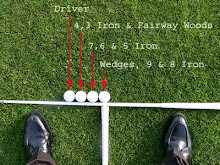Cover Story: Why You Can't Putt
Why Your Putter Hates You
If you haven't been fit right, you're asking for trouble
By Mike Stachura
October 2010
Tom Morton, director of the Player Performance Studio at Haggin Oaks Golf Super Shop in Sacramento, Calif., says at best one in four golfers are using the right putter. "Maybe. And that's mostly by luck."
The reason: Too many golfers choose their putters the way they choose ice-cream flavors, instead of taking advantage of a science-based fitting session that uses a system like the SAM PuttLab or the Tomi that reveal how efficient your putting stroke is and how it changes when you switch putters.
Says Brent Norton, director of fitting at Miles of Golf in Ypsilanti, Mich.: "When customers walk out of a proper putter fitting, they know what type of putter will complement their stroke, why they miss putts the way they do, and what they need to work on."
The right putter will improve your direction and distance control. Here's a basic guide:
LENGTH
A putter shorter than 35 inches (the typical off-the-rack length) is better for most golfers. If your putter is too long, you'll have too much space between your body and elbows at address and your arms won't hang naturally. Telltale signs are scuffed putts, or the toe off the ground at address. Says Norton: "When we look at length, we're trying to get the player in a neutral setup, with the eyes over or slightly inside the ball. This allows the golfer to release the putter freely and see the line easier." Many fitters use a telescoping shaft to match length to the player's posture.
ALIGNMENT FEATURES
"You can have the right length, lie and loft, but if you're not aimed correctly, you won't hit it solid," Morton says. Many facilities check your aim with a laser device so you'll be able to see how different elements (circles, half-circles, lines) can help get you aimed at your target.
LOFT
You need more loft on your putter -- at least 4 degrees -- if you play on slower greens or start your stroke with a forward press, which immediately delofts the putterface. You can get away with less loft on faster greens or if you contact the ball on the upstroke.
HEAD SHAPE
If your putts often come up short, you might be making off-center contact. A larger head with a perimeter-weighted frame that's more stable on off-center strikes will help. A blade putter looks more like your other clubs, so you might be more comfortable with it.
LIE ANGLE
If the sole of your putter is not level with the ground at address, you'll leave putts short (because you're not contacting the sweet spot on the face). If the putter's toe is off the ground, even a perfect stroke will lead to a miss to the left.
WEIGHT
Generally, a lighter putter -- under 340 grams -- works better on slower greens (because you need to swing the putterhead more), and a heavier putter provides stability on the shorter strokes used on faster greens.
Read More http://www.golfdigest.com/golf-equipment/2010-10/putting-mike-stachura#ixzz0zdxRhP00
Subscribe to:
Post Comments (Atom)





No comments:
Post a Comment